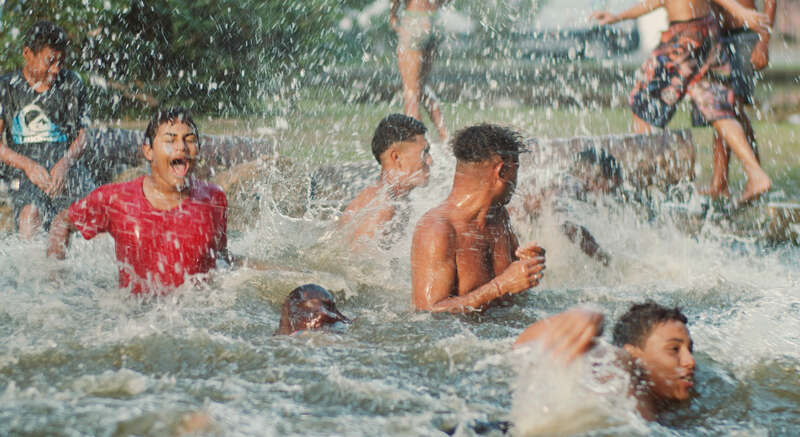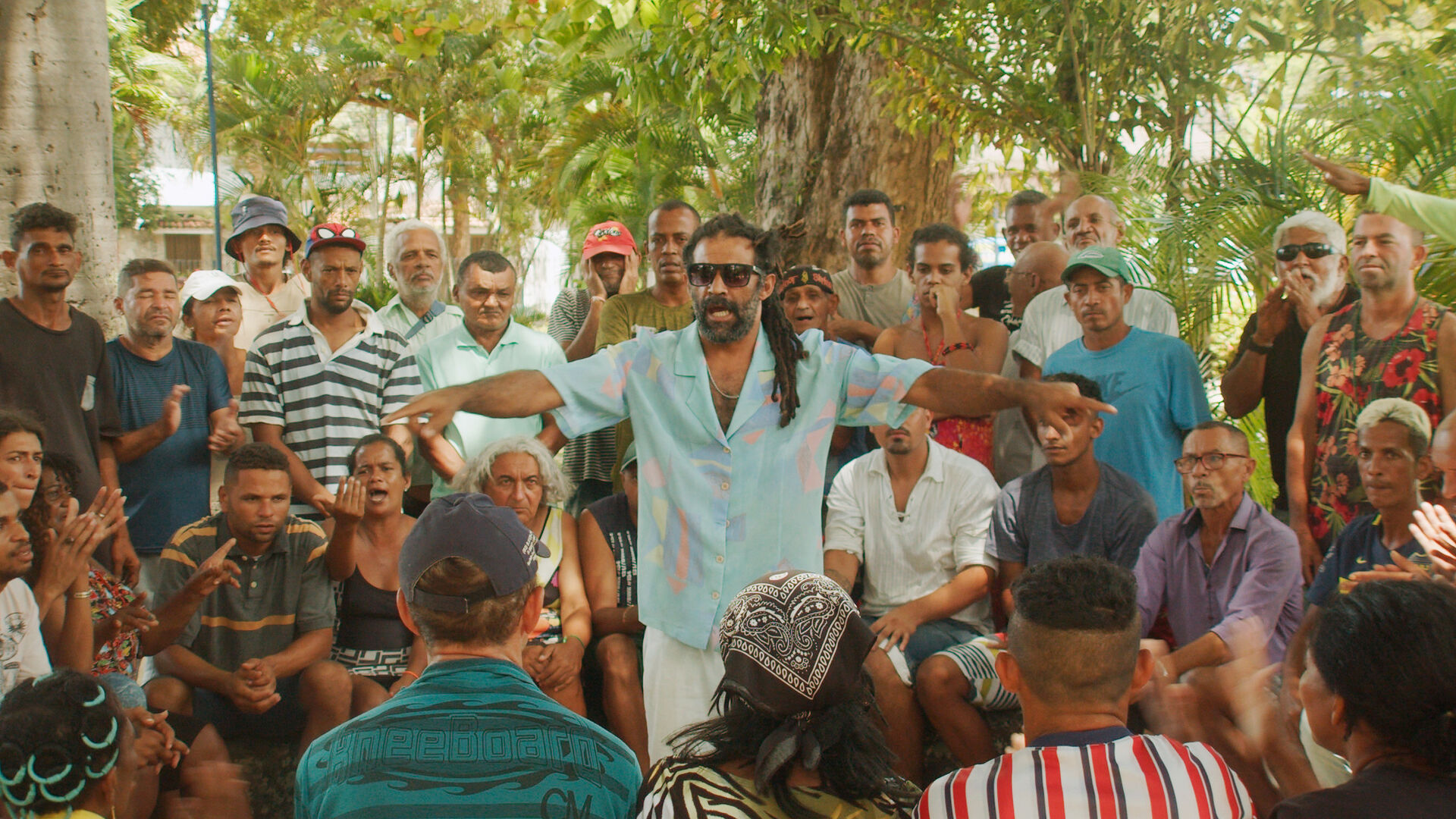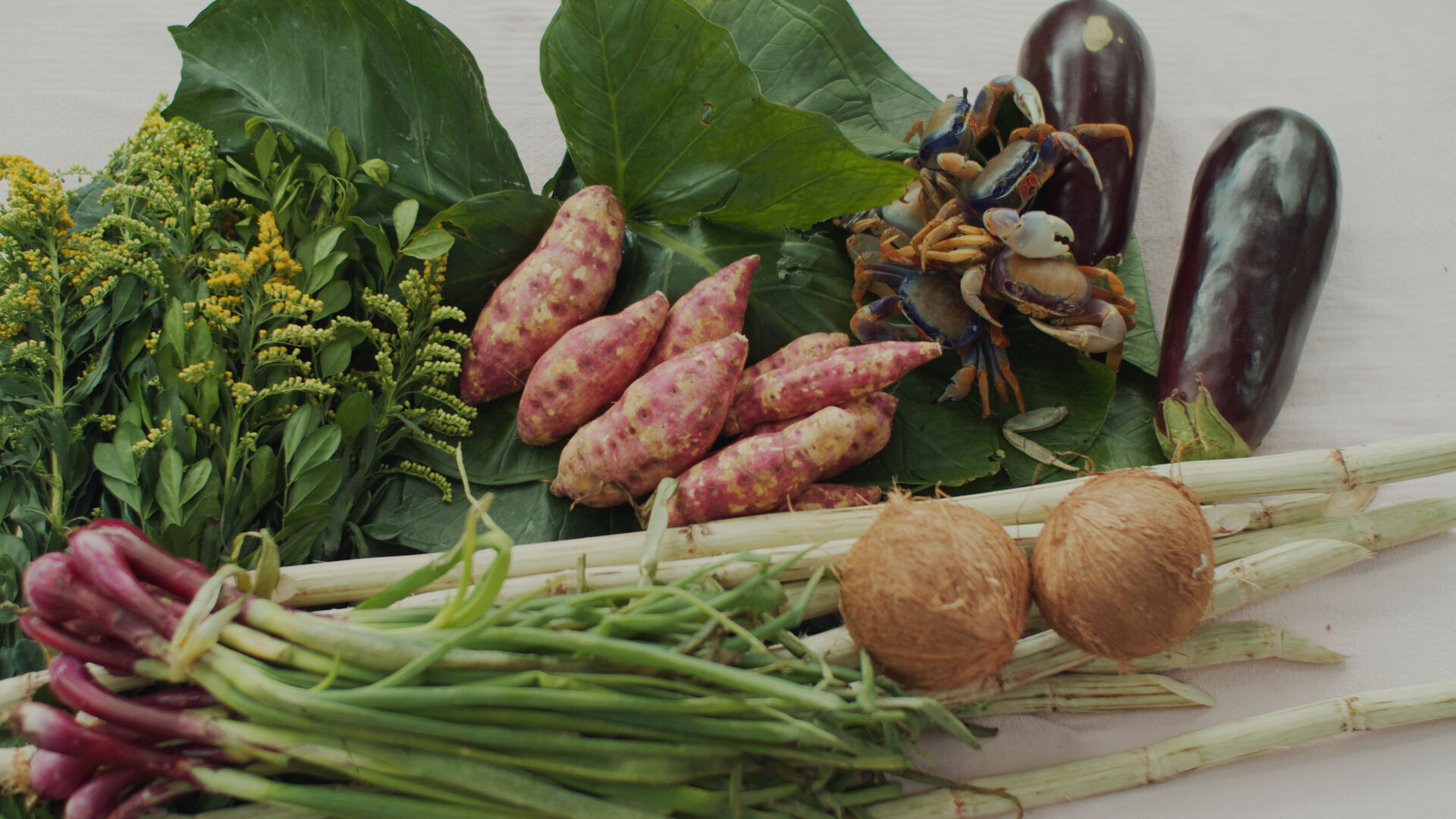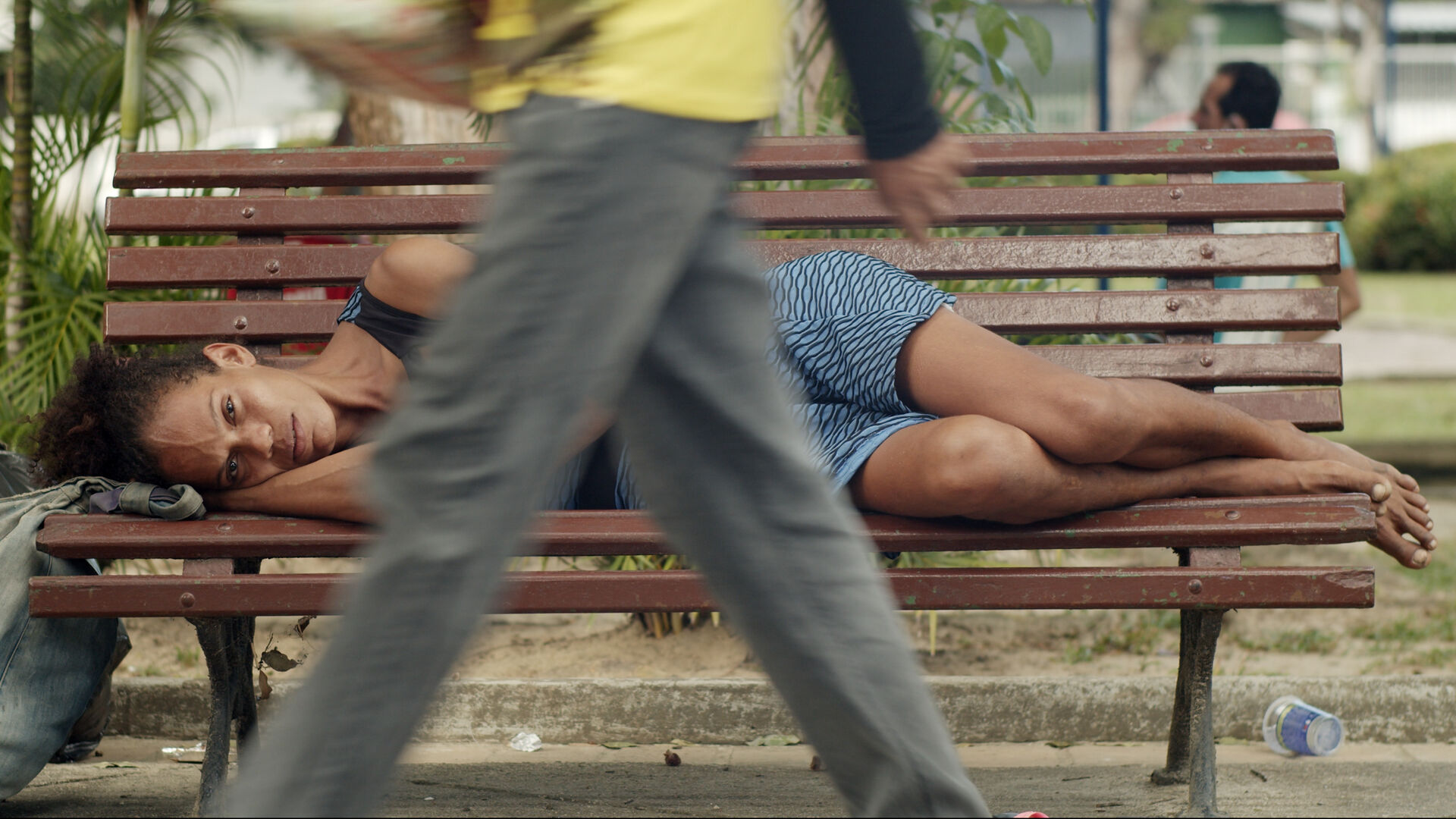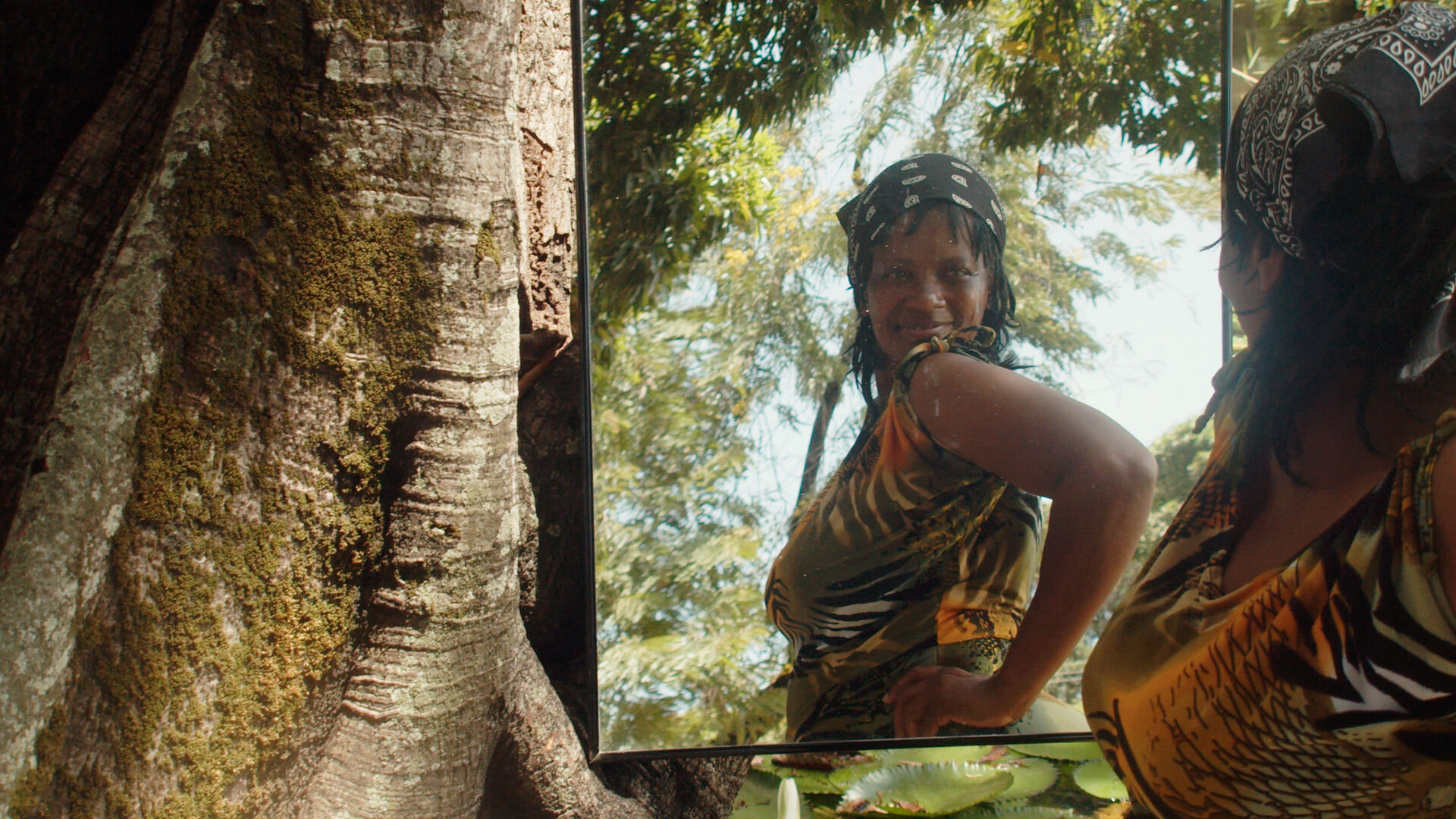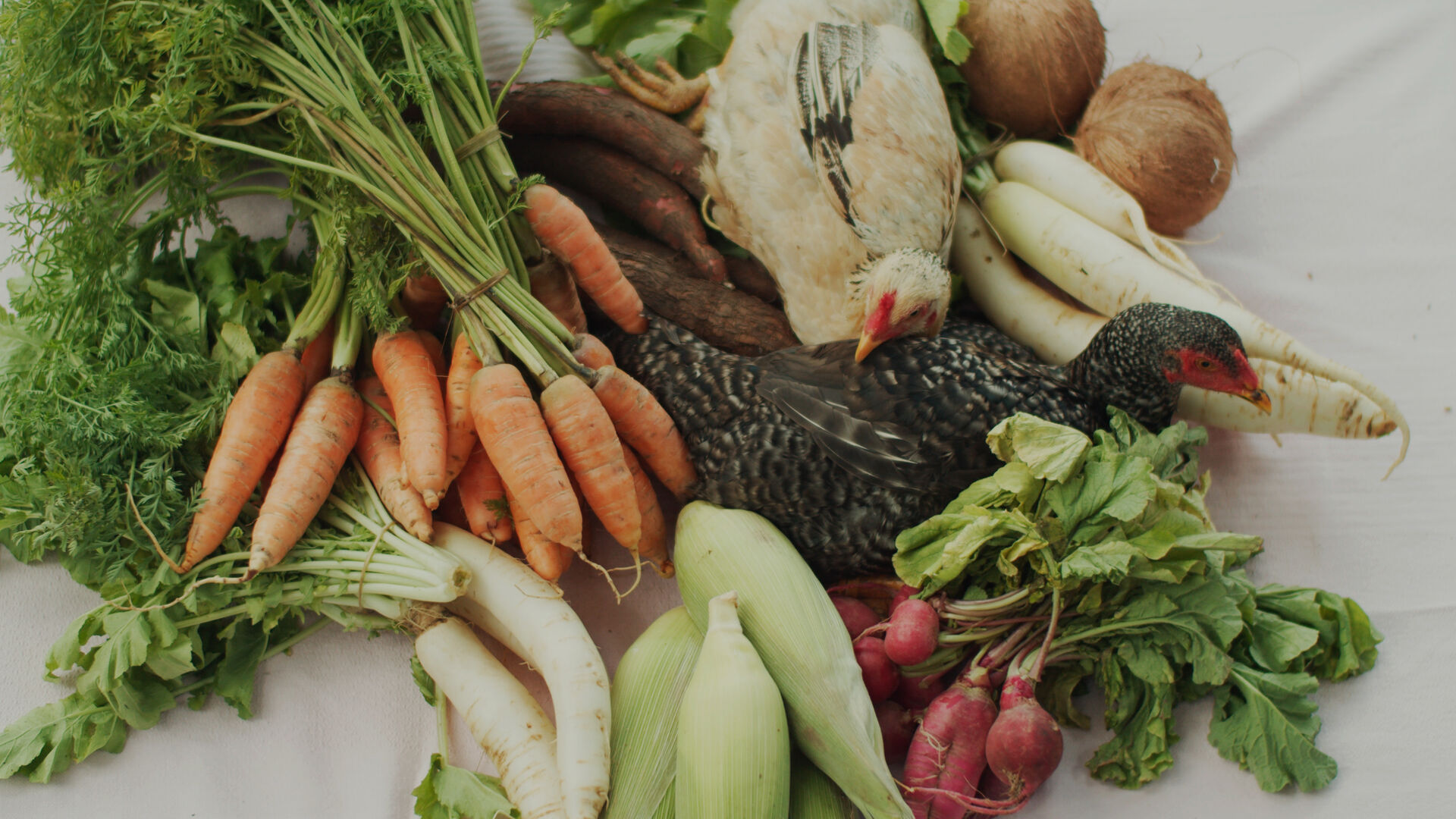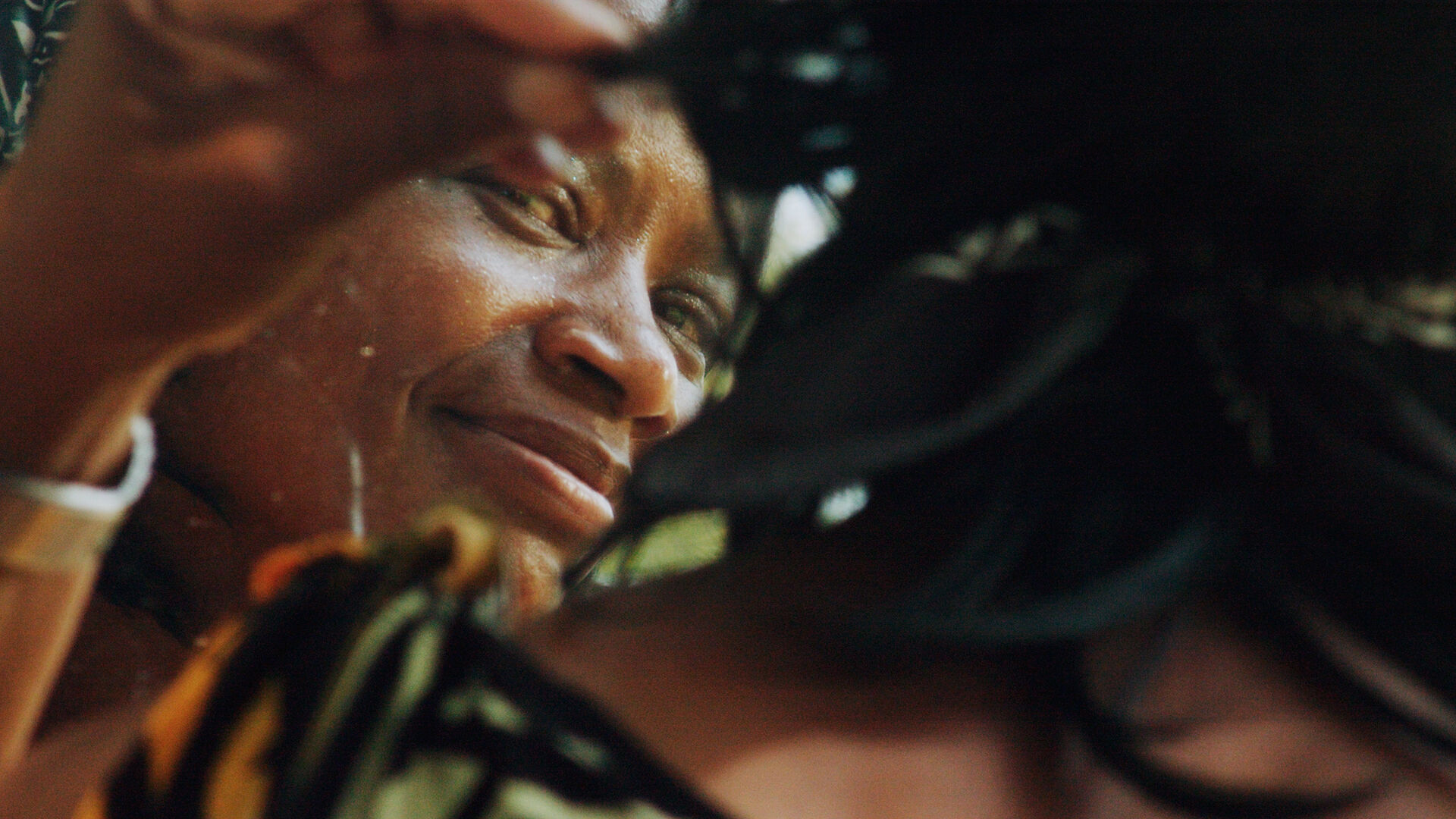Sitting in a plaza in the centre of Recife on a Friday afternoon, near a bustling public market and equally bustling streets, I await the arrival of Jailson, Jefferson (also known as Cat Face, which is how he presented himself to me), and Fagner, with whom I would speak for the rest of the day. These three men had one thing in common: for more than a decade, they had dealt with the reality of being unhoused. We were meeting to discuss a film made by the artist Jonathas de Andrade, in which two of them had participated, along with a hundred other unhoused people. Out Loud (2022), the film in question, had been shown at the Fifty-Ninth Venice Biennale’s Penumbra exhibition, as part of the collective screening at Fondazione In Between Art Film at Venice’s Complesso dell’Ospedaletto, from April to November 2022, in which de Andrade represented Brazil. It had a significant impact among its viewing public, but most especially among the people featured in the film. These are people in socially vulnerable positions who participate in Movimento Pop Rua, a social movement that fights for human dignity and access to basic rights for the unhoused population in Recife, the capital of the Pernambuco state in north-eastern Brazil.
The action in Out Loud centres around the preparation of collective meals; the film is divided into eight acts, which serve as chapters that exercise different forms of seeing. As is frequently the case in de Andrade’s work, the intersection between fiction and reality is hard to dissolve. De Andrade understands that inviting people to represent themselves is a potent gesture, and that making such an invitation does not always imply representing people in a documentary way. He believes in the exercise of admitting to one’s presence on a sort of stage; further, he believes that when people see the camera pointed at themselves, it is an exercise that impels them to tell their own stories, or to become conscious of their own stories. The actors in de Andrade’s films are precisely the people who are or have experienced these conditions in their own lives.
It is possible to point to the hybrid nature of Out Loud through two distinct tendencies. Beyond the aforementioned element of working with actors who have experienced the reality they are representing, de Andrade’s productions frequently deal with bodies or social groups that are distinct and distant from his own reality and personal experiences. It is through this tendency that Andrade’s work takes on especially problematizing layers. This mixture of diverse dimensions, potentialities, and fragilities, as well as de Andrade’s embrace of other bodies or social groups, can be read as opportune (or inopportune) in our current context, both in Brazil and throughout the world.
Brazil is experiencing a challenging moment in its political history due to the (dis)orienting administration of its current president. As a result, the layers of complexity interwoven throughout the country’s social reality – and, therefore, the insertion of de Andrade’s work within this social reality – are amplified. Jair Bolsonaro’s government is blatantly responsible for a calamitous social context: high unemployment levels, a plummeting minimum wage, and the rollback of public policies relating to the environment, public health, education, culture, human rights, and welfare, all of which are directly related to an increase in the number of people living on the street. In December 2021, there were 158,191 people living on the streets of Brazil;This data comes from the Brazilian Observatory of Public Policy with Homeless Populations, part of the Trans-disciplinary Programme in Centres of Citizenship at the Federal University of Minas Gerais (POLOS-UFMG). In December 2021, according to Brazil’s CadÚnico programme, which registers families living in extreme poverty, 158,191 people were living on Brazil’s streets. by May 2022, that number is estimated to have grown by 16 percent.
Additionally, the number of unhoused people in Brazil has historically been related to processes that derive from the country’s colonization. The passage of Imperial Law 3,535 of 13 May 1888 – better known as the ‘Golden Law’ – was an historic fact that was unquestionably responsible for casting infinite Black, Indigenous, and Mestiço Mestiço is a way of referring to human bodies born of inter-ethnic relations. It refers to someone without precise racial identification. Originally, the word comes from a Latin root that denominates those born to parents from different racial backgrounds, e.g., the Mestiço child of a white woman and a Black or Indigenous man.bodies out onto the country’s streets with no access to rights or strategies for being absorbed by society. Because abolition occurred without social strategies for reparations or for attending to the needs of people ‘freed’ from slavery, the enslavement of populations in Brazil even after the implementation of the Golden Law was responsible for the continuation of the process of marginalization in which a significant part of Brazil’s Black, mixed-raced, and Indigenous bodies live to this day, without real rights to citizenship, work, or housing. How can a film that touches on and lays bare some of the causes and narrative identities that are crucial to contemporary Brazil give potency to bodies and lives that, based on the social and human dynamics of our worlds, suffer raw and open processes of a denial of privileges?
Excerpt from Olho da Rua (Out Loud), 2022 / Jonathas de Andrade / Vídeo, 25min, HD / Commissioned and produced by Fondazione in Between Art Film
Out Loud is divided into acts and was filmed over the course of two days, with much of the action taking place during collective meals shared by unhoused people. The work spans the population that lives on or through the streets, showing the situations and conditions in which they live, and their positions of gender, class, and raciality. These situations and conditions are also related to the challenges of 2022 in Brazil, to the (dis)government of Bolsonaro, to the Covid-19 pandemic, and to the Brazil that, day after day, hurriedly returns its population to hunger and food restrictions. In the Brazil of 2022, 33.1 million people experience hunger due to serious food insecurity, and this segment of the population consists disproportionately of Black bodies living on the country’s urban peripheries. Out Loud emphasizes the urgency of these issues.
I suppose that a significant part of the world, or at least the world read as the Global North, may not know that Brazil is passing through a fortuitous and intense period of further elaborating its ethnic constitution, its identities, and the narratives produced here. Brazilians are demanding the valorisation of their ethnic identities, from Indigenous and Aboriginal roots to Black and Afro-diasporic origins, all of which have been decimated, erased, forgotten, or relegated to ostracism for centuries. This began with the colonial process, and today’s Brazilians yearn to be able to construct their own narratives with their own hands, voices, words, and bodies, ridding themselves of all outside mediation. For these reasons, and for infinite others, Jonathas de Andrade’s work passes through an effervescent landscape of issues; it comes to a boil and throws itself directly into a structurally and aesthetically challenging context. This prompts us to ask questions: In what way are socially hybrid collaborations useful? Is the product of the work fiction or documentary? Were there negotiations in the story? How did the bodies that protagonise the film manage the contradictory dimension that such a work presents?
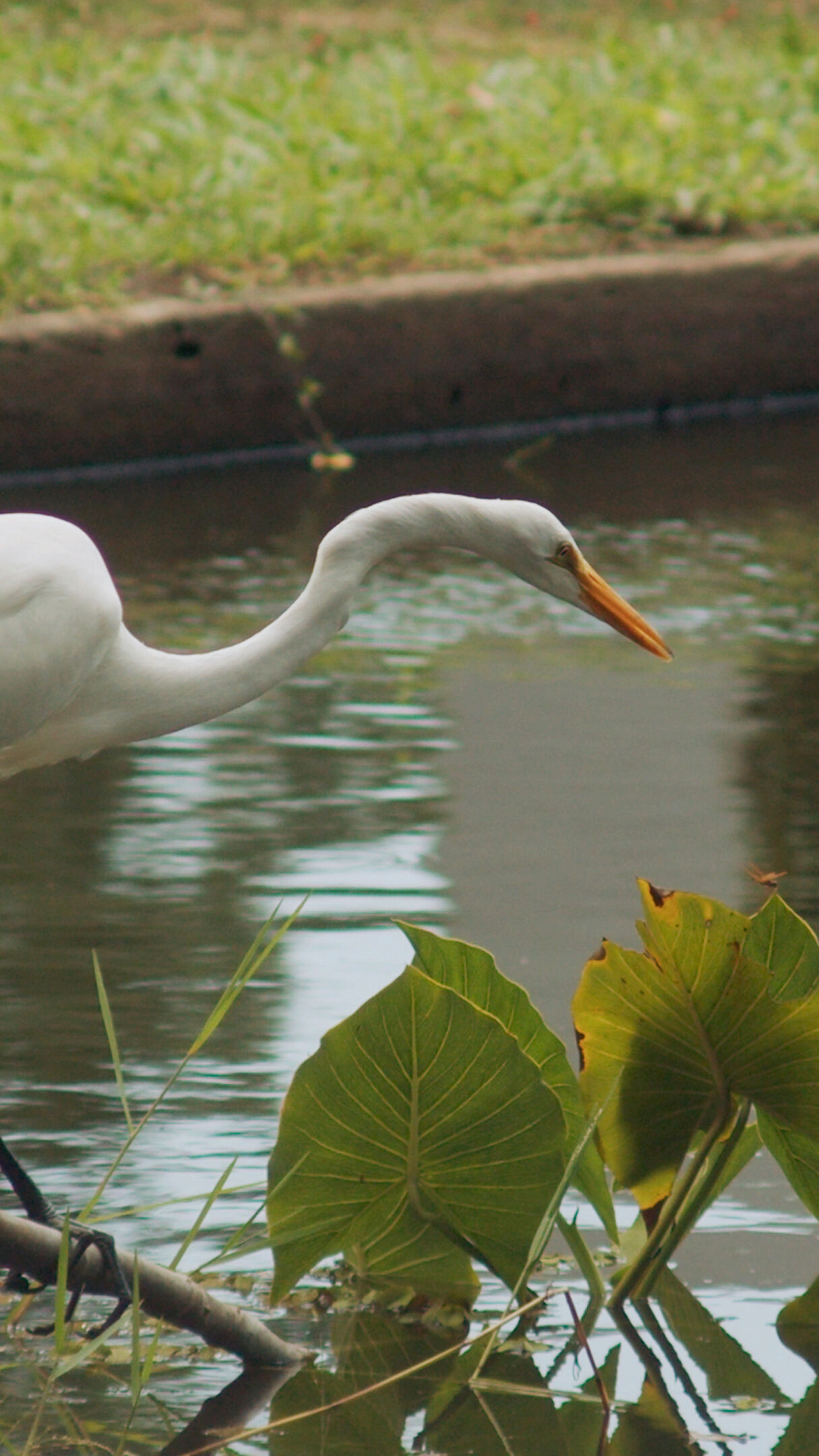
Still from Olho da Rua (Out Loud), 2022 / Jonathas de Andrade / Vídeo, 25min, HD / Commissioned and produced by Fondazione in Between Art Film
Let us not forget that this film is not only made in or about the Brazil that the world is accustomed to seeing, that hegemonic and internationally known Brazil that converges on Rio de Janeiro. The film is made in north-eastern Brazil, which some could certainly call a slice of the south of the Global South, inasmuch as many Brazilians who live in the country’s south-east – a region that includes Rio de Janeiro in addition to the cities and states that surround it – consider Brazil’s north-eastern region to be a place of inferior persons, inferior bodies. North-eastern bodies and north-eastern people are biologically and historically associated with the intense miscegenation between Black people brought from Africa to be enslaved in Brazil and Indigenous, original people and cultures. As such, people from north-eastern Brazil experience a cultural and ethnic arrangement that differs from the country’s south-east. Brazil’s south-eastern and southern regions have historically received a huge number of white European immigrants; these regions routinely see themselves as superior to the people of other regions of Brazil, such as the north and north-east. This, in turn, produces Brazilian dynamics of intra-colonialism. And it is precisely because of violent colonial arrangements – arrangements that colonise mentalities, as well as ways of seeing the world and of living in it – that north-eastern Brazil, or Brazil’s north-east, possesses peculiarities that must be seen. They must be seen so that the context that is intrinsic to de Andrade’s work, that is imposed on it, and that constitutes it can be understood.
Brazil’s north-east, where Out Loud takes place, consists of nine states: Alagoas, Bahia, Ceará, Maranhão, Paraíba, Pernambuco – the capital city of which, Recife, serves as the film’s location – Piauí, and Rio Grande do Norte e Sergipe. All of these states are on the coast of the Atlantic Ocean. The north-east comprises 18.2 percent of Brazil’s total area, and its Human Development Index (HDI) is 659, which is considered medium. It has 53,081,950 inhabitants, 28 percent of the total inhabitants of Brazil, and is considered Brazil’s second-most populous region, after the south-east. Brazil’s north-eastern region presents various socio-economic problems and challenges; as a result, its states are the lowest in the national HDI ranking. It has the highest infant mortality rate in the country – 33.2 deaths per 1000 live births – and almost 55 percent of homes in the region do not have access to basic sanitation. The life expectancy of north-eastern bodies, estimated at 70 years, is Brazil’s lowest. In 2012, Brazil’s National Research of Housing Samples (PNAD) recorded that 26.5 percent of people in the north-east self-identify as white, while 73.5% self-identify as Black. (This figure includes both Black and pardo bodies. Pardo is a Brazilian identification that denotes mixed-race origins without identifying precise racial makeup. However, the classification of pardo bodies and people is being ever-more problematised in contemporary Brazil.) Of the 73.5 percent of Black north-eastern bodies, only 8.7 percent self-identify as Black, with the other 64.4 percent identifying as pardo. Meanwhile, in south-eastern Brazil, 55.2 percent of the population identifies as white. In southern Brazil – the ‘white’ region bordering the south-east – 79.2 percent of the population self-identifies as white.
In order to write this text about Out Loud, and with the aim of strengthening voices that do not often find spaces in which to speak – or, to put it better, bodies that are restricted to the margins of what is audible or visible – I chose to converse separately with the film’s actors and with de Andrade. At the beginning of August 2022, I began contact with forty-seven year old Jailson José dos Santos, who is active in the leadership of Movimento Pop Rua. He, in turn, invited Jefferson Alves Ferreira and Fagner Valença, both thirty-four, to speak with us.
To begin, I asked the actors what it was like to make a film in partnership with an artist like de Andrade, a white man from another social class and social reality, who brought the idea of making a film together with unhoused people. Jailson immediately said, ‘I learned this very quickly and early on that it has to be like this, that we have to join together in awareness and form friendships . . . in order for people to identity with us, to say that we put in effort and to see that we’re “good blood”‘Good blood’ is an idiomatic Brazilian expression used to denote or indicate pleasant, cordial, or benevolent behaviour. and that we want change’. To this, he quickly added, ‘The film touches on the reality of unhoused people, and it’s faithful to what we live through on the streets, because it shows different things . . . There’s the question of hunger, of feeding, of sharing – you see in the film that there’s sharing . . . In the film, you can see that we share, that we are hungry and that we need to eat, but that others also need to eat and we only have this plate or this food . . . so let’s divide it, let’s eat together if there’s only one plate. I’ll take one forkful and you get the other. That’s what the street is: this companionship, this experience of overcoming, of knowing others’ realities and their needs. That’s why we share. The film was really great.’

Still from Olho da Rua (Out Loud), 2022 / Jonathas de Andrade / Vídeo, 25min, HD / Commissioned and produced by Fondazione in Between Art Film
Our conversation kept flowing, and between words and other forms of sharing, we elaborated on the effects that the film was capable of producing in their personal lives. Jailson said: ‘We want another film. . . . We want to make one where we can show what happens in the daily life of an unhoused person, from beginning to end. The theme we want [to show] is unhoused people, their everyday lives, just like a laboratory, you see everything that a person does in their day to day. . . . Out Loud touched on all of the themes; it gave an overview of our general reality . . . But look, we’re thinking now of a theme and a slogan for our social movement’s campaign, and for the national forum of social movements for unhoused people: “One Life Alone” (“Uma Vida Só”). Because even in a crowd, piled up with a whole bunch of people, that’s how we feel: we feel alone. We’re not incentivised to feel that we belong. . . . You don’t really have friends – you have people you know but you don’t have companionship, you don’t have love, sometimes you have companionship, but not all the time. . . . People aren’t connected to you. . . . That’s the stronger word: connected. So that’s why this theme is important: because we’re never united. We only get together for food.
The four of us were seated in a public plaza in Recife’s city centre, in front of the Church of the Patio of the Holy Cross, which offers food to people in need. The three men looked on, pointing to, explaining, and commenting on what we were seeing. Jailson noted, ‘In a little bit, since we’re sitting here in the plaza of the Holy Cross, you’ll see . . . this will all be crowded with people living on the street or going through financial difficulties, who come here to get food. This is Cáritas. Cáritas, founded on 12 November 1956, is the Brazilian wing of Caritas Internationalis, which consists of 170 member organizations. It began through the mobilizing actions of Bishop Hélder Câmara, who at the time was Secretary General of the National Conference of Brazilian Bishops (CNBB). Caritas was shaped by Vatican II and has since taken on the values of a transformational ministry. In Brazil, Cáritas is part of the National Conference of Bishops, and consists of a network of 187 member organizations in twelve regions and through five articulating bodies. See https://caritas.org.br/ At four in the afternoon, people will start arriving. People are already hanging bags on the fence around the church to mark their spots. And this is the struggle of the street: it comes from this, this marking of places in the queue for food. If people don’t respect those places. . . . Yesterday, there was a stabbing here. It’s a mess. . . . The question of having to defend your life is very present on the street. Life is very aggressive. And what’s interesting is that the film managed to bring together a lot of people on the street around an objective. The film shows reality; it was really good, really nice to see. . . . The question of food insecurity is an issue. It’s the issue of a lack of assistance, because people are still living on the street, and the lack of public policies, housing, food, and basic rights. . . . Dignity is in [Brazil’s] Federal Constitution, you know?’
I asked if the film had been an instrument that united this group and the unhoused people who had acted in it. Jailson responded, ‘It united us. Because here, we see others passing, we know who’s who, but we don’t get together. On the street, we know who’s out there, but we’re not together. And on the day of the filming, everyone was there, together, all day. . . . We had a moment to participate, to be able to be actors or actresses, to earn a little change, so that everyone could make their own guide.’‘Make one’s own guide’ is a Brazilian expression used to refer to caring for one’s own necessities in life.
Jailson went on, ‘We accepted it because we thought it was cool, but we also want to think of other opportunities. I even spoke to Jonathas about this, about having another opportunity for us to build together from the beginning so that, in the future, there can be material produced and filmed by unhoused people themselves. Movimento Pop Rua is being trained for this.’
Jefferson added, ‘For me, since I was still unhoused, seeing myself in the film was something very important. Because I felt that someone was caring about us. . . . How can I say it? Like, with the film, you could see that there were still people who believed in us, who believe in us, and who give us opportunities to conduct a film. There’s a story in the film, right? This was very gratifying. Including, after the film, I only stayed out on the street for another three or four days. And then I went to live in the house where I’m still living today. In less than a week after the experience of the film, doors were opening for me. I’m in a church-sponsored rent assistance programme today, and these days I’m married. And all of this happened after the film, after I was sort of all over the place. Afterward is when it became set.’
In examining the effects that the film provoked, we began by discussing dimensions that can be seen either as reality or fiction in Out Loud. Jefferson told us, ‘For me, it was all true, practically. . . . I don’t know that there was anything that was fake. . . . Like, there wasn’t anything fake, but maybe the only thing that wasn’t like it is in reality was the film’s tranquillity. . . . All those tables, the knives, spoons. . . . We don’t eat like that, yeah? It just doesn’t happen, not even in the peoples’ restaurant on the periphery; when they serve food to unhoused people, it’s with plastic utensils, because they’re afraid that we’ll get embroiled in each other.In this usage, to become embroiled means to be involved in a fight or altercation. There are a lot of fights on the street, a stabbing in the middle of a fight over cardboard in the middle of the night. The fights are all over cardboard, cardboard to sleep on. . . . At the end, that part about going to look for cardboard that appears at the end of the film seems easy, but in reality, it isn’t. In the film, they had mattresses for us to lie down on, as well as cardboard.”
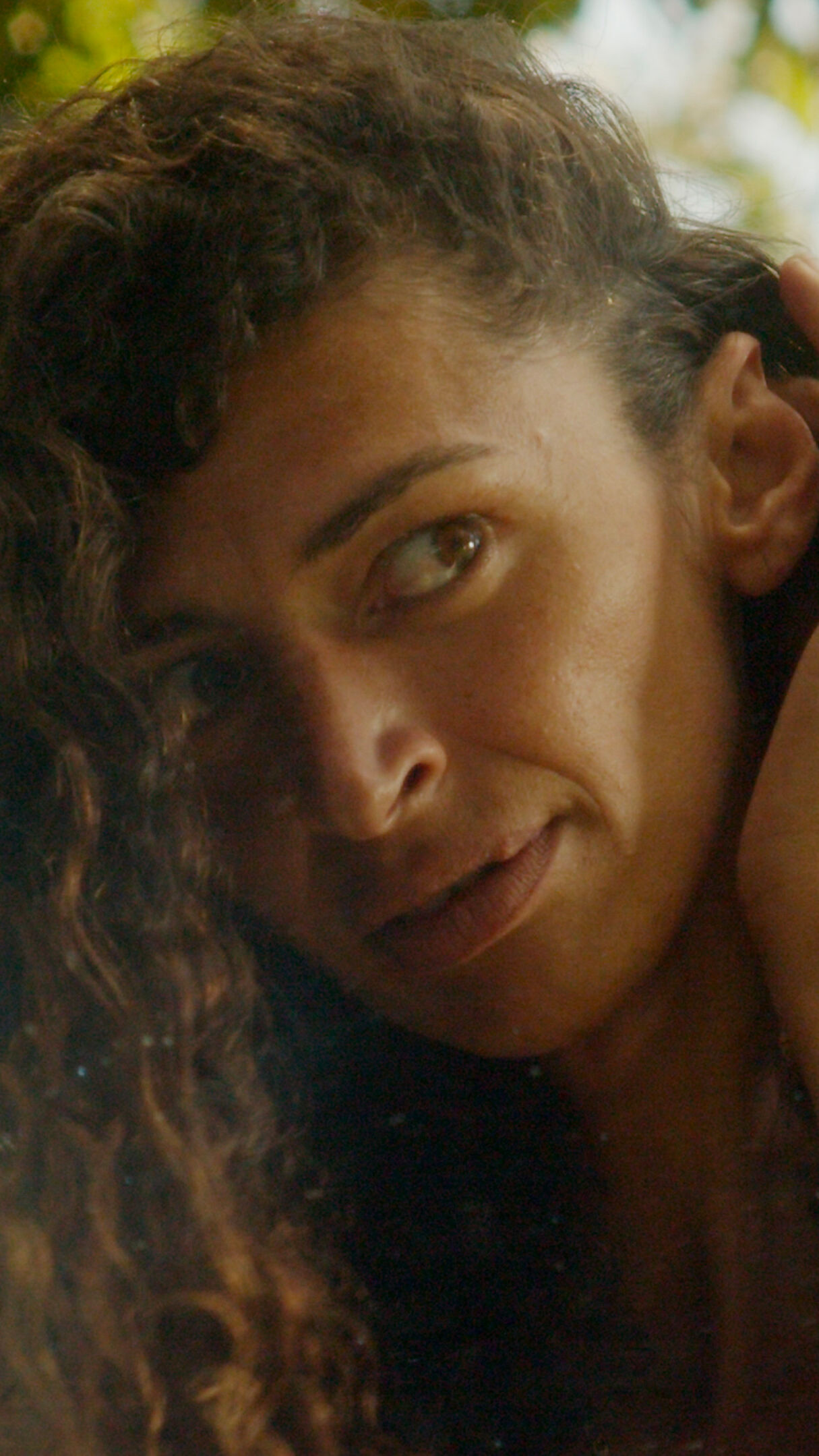
Still from Olho da Rua (Out Loud), 2022 / Jonathas de Andrade / Vídeo, 25min, HD / Commissioned and produced by Fondazione in Between Art Film
Fagner continued, “Were there couples fighting in the film? Jealous fights, couples’ fights – those also happen all the time on the street. Because the reality of the street doesn’t fit; it’s too much, it’s a lot. . . . It extrapolates that dimension of filming. . . . If you’re here, you’ll see it in a little while, even in the queue for food here. . . . Look at how it is now, and you’ll see how it’s going to be in a little while; [you’ll see] the fighting that will arrive when the food is almost ready. . . . You see the confusion in loco, the wood splinters, ‘The wood splinters’ is a Brazilian expression indicated violence or aggression. you can’t capture that in fiction, on film. Now I want to see our film on Globoplay!’Globoplay is a digital platform for on-demand video and audio streaming, developed and operated by Globo, Brazil’s largest television network. For several decades, Globo has been responsible for fomenting and manipulating the imaginary and the narrative of millions of Brazilians.
Jailson brought the following observation to our collective reflection on the film: ‘Look, even with food for everybody, plates for everybody, utensils for everybody, cardboard for everybody, and even mattresses for us to lie on. . . . Even so, there was still sharing, even with everything for everybody, there was still sharing.’ Fagner added, ‘There were no police on top of anyone, right? No police kicking people out.’ Jailson continued, ‘Yeah, no police going after anyone, no one being woken up or expelled from places.’
Later, we talked about possible contradictions experienced in the film and on the streets by bodies that occupied both. Here, the reflections were relentless. Jefferson described one point of dissonance: ‘You know what’s a contradiction with the street? After four days, there’s a period where you start to connect, after four or five days. . . . In my case, with the film, I got on rent assistance, but I only slept in the room I rented through the church on the first day, because I went to stay with my wife. The first day I slept there, and then the next day, when she had to go to her house, I slept on the street for two days, by that building in the middle of the street, until I started thinking, like, wait, didn’t I get a place so I could leave the street? Why have I returned to the street now?’
Jailson added, ‘See that guy over there? He’s a metal worker, but he lives on the street because he has a problem with drug addiction. And so his work can’t support his lifestyle. . . . His work can’t provide for his addiction; he can’t pay his rent and his addiction. . . . I’ve known him for many years, and he works. If you see him, he’s working; he works all day, he has a workshop, but he can’t manage. So there’s that – there are some things that we can’t leave behind. The habits of the street itself. . . . I don’t have any of those anymore, but that isn’t always the case.’
Fagner noted that this was consistent with his experience: ‘Me, even though I haven’t lived through homeless life, I lived through nights [on the street] when I wasn’t working. . . . I was a worker on the night shift, and then on the next day, my day off, I didn’t stay home at night. I’d be stumbling through the streets until morning. I’d have coffee at the Santa Rita Quay, go to the mangrove swamp to see the night moon, go to the sugar warehouses at Recife’s port. . . . I experienced countless mugging attempts, but I felt like the street was mine, and I wouldn’t stop wandering the street in the middle of the night. And the middle of the night is when everything happens. It was difficult to let go of that. It’s been a few years since I stopped being a night owl.’
After my encounter with Jailson, Jefferson, and Fagner, I had the opportunity to talk with de Andrade about some of the contradictions in his works. And talking with him was very elucidating. ‘Of course it’s very easy for you to enter into confusions about [who holds] power between narrative games,’ he said. ‘As an author, I – a privileged person – can manipulate narratives. All of this brings enormous risks, and I’ve learned a lot about this in my trajectory up until now. However, throwing oneself into the risk of contradiction is different than being taken as a spokesperson for the agendas of the past. I don’t want to talk for others, but rather with others.’
Confronting the dimension of the challenges in which he is immersed, de Andrade said, ‘I come from a place of privileges, and in this encounter, I can recognize this and construct empathy, so as to make my work a channel that amplifies the sensibility of other people who are in privileged situations, as people who go to museums tend to be. . . . I believe in art as a place of absolutely radical pedagogy. I think that various forms of art exist, and various functions of art, depending on where the work goes. And the work can be a more utopic art that points to historical reparations, that points to rewriting hegemonically known narratives. Or the art itself can be a place for building doubt, an art that builds and provokes critical thought and makes us think about what reality is, what the truth is, or what lies are. And today more than ever, we need this discernment. We need to build a well-sharpened critical spirit at all times. I see that art can be a kind of capoeirista.A capoeirista is someone who practices capoeira, a popular folk practice in Brazil that results from the hybridization and resistance of people of the African diaspora colonized in Indigenous Amerindian lands. Capoeira was created in response to the violence to which enslaved people were subjected during Brazil’s colonial and imperial times. Based on agile corporal movements and attacks, it is a form of fighting that allowed its practitioners to defend themselves against the brutal persecution of the ‘wilderness captains’ (capitães do mato) who set out to capture those who had escaped enslavement. Movements derived from capoeira were also incorporated into dances and folk dances throughout Brazil. In Brazil’s north-east – and specifically in Recife, where Out Loud was filmed – capoeira contributed to Frevo, a dance style linked to the region’s carnival tradition. ...It’s an art that makes us watch and question whether it’s about fighting or dancing... an art that makes me wonder whether we’re dancing together, or whether I have to doubt, to throw myself at doubting, at debating.’
It’s undeniable that an important debate is taking place in Brazil and throughout the world regarding this process: the urgency and necessity for the bodies that protagonise artworks to be those who propose the works. This debate has been and continues to be leveraged in countless ways, and the term and concept of ‘place of speech’ has gained space in debates among diverse social groups throughout Brazil.‘Place of speech’ is a term and concept popularized through the work of Djamila Ribeiro, a Black Brazilian intellectual, in her 2017 book What is the place of speech? (O que é lugar de fala?). Ribeiro refers to the place from which a given speaker is located, as well as to discursive points of view in which historically subalternised bodies reclaim their own existence. In response, de Andrade positions himself in the following way: ‘This is a very important debate, because, after all, who can talk about whom? What can I talk about? What’s fitting? Can I only talk about my own narratives, or can I weave together different narratives? Even when we are in a society, and my own privileges are being constructed or reinforced, endorsing the exclusions of other populations? Avoiding these issues maintains the privileges of an exclusionary society. How could I not make this a topic of mine? I cannot give myself that luxury, even though a narrative of unhoused people made by unhoused people themselves is undeniably urgent, necessary, and extremely important. I think that, historically speaking, this has never been so obvious to us as it is now.’

Fagner, Marília, Jefferson, and Jailson, holding the movement flag, Recife, 2022
He continued, ‘We can’t give up on spaces and occasions in which we might have encounters that allow us to build narrative exercises about the world that are subjective and emotional. Because these are places where transformation is made. They are places of absolute collective growth. I think that we ought to do all of this collectively. Designing and creating new narratives, new outlets for this country. Becoming conscious of our own pains, especially in dealing with people who historically have occupied places of privilege. Becoming conscious of these wounds, these places of exclusion, is what makes us exercise possible horizontalities. And in art, this can be a constantly flawed exercise, a constant trial and error, because it cannot be total – it’s always imbalanced. When confronting structural violence and the structural differences between social classes in our country, this is an impossible exercise. But at the same time, this is exactly what makes it something extremely powerful. . . . So I refuse to make art that is only about my own navel gazing, understand? Because my navel gazing is dealing with the here and now, dealing with the tangle of what it means to live in a country of brutal exclusion. Now, it’s clear that this is a gigantic risk, because it’s easy to take on the wrong tone, to be violent in one’s way of portraying others. Being insensitive to others’ fragility is a very real risk.’
While talking with de Andrade, I remembered some of the fascinating, overpowering words I heard from Jailson and his companions during the afternoon I spent with them. They summarized a great deal – almost everything – of what we see, hear, or deal with in terms of the experiences of bodies with which de Andrade has insisted on working throughout his professional trajectory.
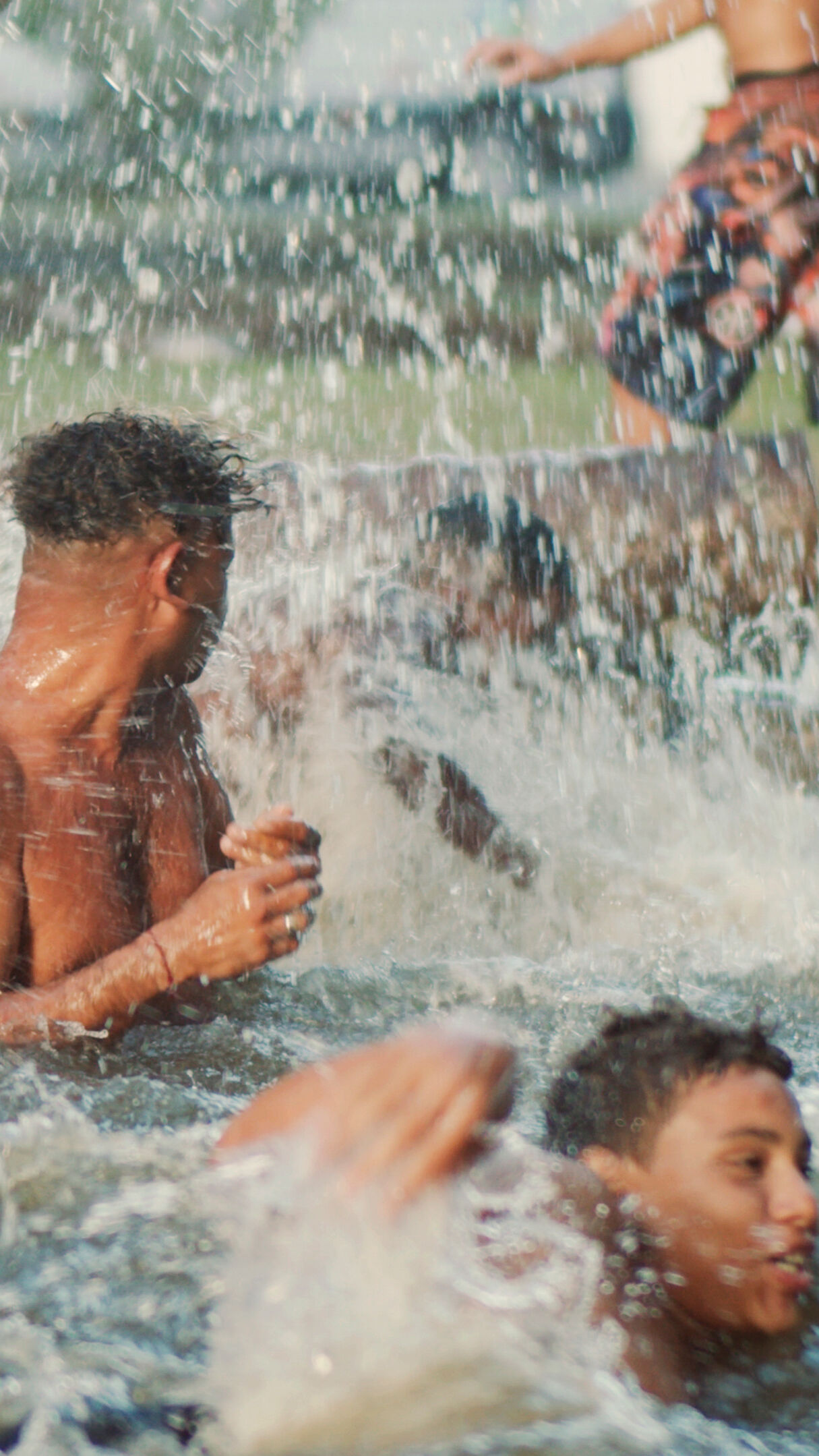
Still from Olho da Rua (Out Loud), 2022 / Jonathas de Andrade / Vídeo, 25min, HD / Commissioned and produced by Fondazione in Between Art Film
Jailson told me, ‘The body of the street is a maloqueiroMaloqueiro is a very common expression in Recife. It frequently refers pejoratively to bodies living on the city’s periphery or on the street. However, it is also used to refer to popular expertise in daily life experience, as demonstrated by Jailson’s explanation.body. A maloqueiro body might have nowhere to go, no destination, but it’s happy. You don’t have what’s necessary, the basics, but you figure it out; you keep getting it, asking for it, arranging it. . . . Getting, asking for, arranging, managing, like that. . . . Being maloqueiro is knowing how to deal with all of this adversity of life, this naked and raw reality that you have to survive, with of all its sudden shifts, with things that happen all of a sudden. So you live like that, living suddenly, all of a sudden, and you live seeing what’s happening, and existing, and continuing, and you keep going. . . . It’s a real damn resistant form of living. That’s how it is on the street.’
Fagner added, ‘It’s like a kind of real athleticism. . . . I know a guy who kept walking all the way to São Paulo, then coming back here and returning, and going again, and showing his stab wounds, the marks of the street. . . . And you see that, especially for the young ones, the body is always in movement on the street. It runs, it jumps, it climbs, it pulls at things, it jumps on to the roof, it’s Crossfit, it’s what the middle class has a hard time with. . . . And the body of the street doesn’t eat right, it doesn’t have much, but it manages to keep the body in motion. No, it doesn’t manage – it needs to! It needs to keep the body in motion in order to survive, for its survival.’
Jefferson continued, ‘There are times when we’re happy, we do an odd job, earn a little change, and help each other out, because there are always two or three or four others for us to help or share with, or maybe there’s a girl. . . . So we have fun, we go to the beach, drink a cachaça, those who use drugs buy their drugs; that’s how they have fun. . . . And then there are times when you feel alone, the moment of feeling alone. Sad. The moment when I used to feel most alone, when I wasn’t stoned, was at nightfall, when I’d see the stores closing. . . . That was because everybody was going to their houses, and I didn’t have anywhere to go. Today, when this time of day comes and I’m going home with my wife, that’s what I tell her.
Finally, Jailson said, ‘The body of the street is a body that might be weaker, but it becomes stronger, because that’s what survival demands. . . . Because it lives at the limit, in search of survival. Because dying is very easy; what’s difficult is surviving.’
Jailson and his comrades are a few of the many in Brazil who survive – who (re)exist in absentia and reinvent themselves as they tell their stories and understand themselves as this maloqueiro corpus, living the intrinsic contradictions and violence of their daily lives and social experiences in powerful, unequal, and controversial north-eastern Brazil.
The work of de Andrade exists at the confluence of the cracks within these contradictions by which the lives of his actors, collaborators, and partners are formed. These are Brazilian people who live under the maxim ‘dying is very easy; what’s difficult is surviving’. These lives intersect and become entangled in the works, experiences, and trajectories exposed by the artist’s production, and by the social groups that collaborate with him.
Translated from Portuguese by Raphi Soifer
This contribution is co-published by Revista ZUM. The Portuguese version can be read through Revista ZUM
This article was commissioned by Trigger in the context of its upcoming printed issue Trigger #4: Together – to be published in February 2023. This issue is guest-edited by Susan Meiselas and explores collaborative practices in photography and beyond. Sixteen contributions engage with strategies of co-creation that stretch notions of authorship and ownership, breaking through existing heteronormative, state-owned, or hyper-individual categories.
